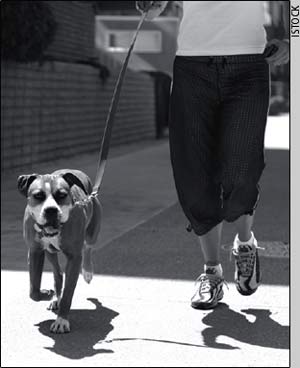June 2006: Well-heeled Dog
Real World Manners
Civilized Canines on the Streets and Off
by Trish King
Having a happy relationship with your dog means learning how to work together. If there´s a topic you´d like to see Trish cover, email editors@fetchthepaper.com.

You’re walking along a sidewalk in San Rafael or Petaluma and a mother and child approach you from the other direction. Suddenly the child throws herself at you, smiling and laughing. She’s been eating an ice cream cone, which is now all over your clothes. You try to be nice, but really! A few minutes later, another mom and child approach. You say hello, they say hello, and you both go on.
Let me introduce you
Though the first scenario isn’t very likely, such a scene happens frequently when the approaching couple is a dog and her guardian. In too many cases, guardians look at their dogs as though they can do no wrong, while the people approached try vainly to remove the dog (and the footprints) from their clothing. It’s a good idea for dog guardians to remember that even fellow dog lovers may not want to get too up-close-and-personal with strange canines. It’s very difficult to teach some dogs not to jump up; others are easier.
We should all teach our dogs to sit for greetings. It can be a long process, however, since most dogs want to jump up to visit. However, it can be done. During the learning process, management is the way to go. Don’t let your dog close enough to a stranger to greet him. And don’t allow strangers to give your dog treats. Though that might seem like a good idea, it can teach friendly dogs to be too friendly and look upon all strangers as treat dispensers. Also, cautious dogs can get frightened; they may take a treat and then try to retreat. If they can’t get away, they could snap.
There’s often a huge temptation to tie your dog to a parking sign post or bench while you pop in for a quick purchase or a cup of coffee. Though some dogs can handle that, many cannot. You’re putting your dog at a huge disadvantage if he’s approached by a human or other dog. If he is approached incorrectly (maybe an over the head approach by a friendly but unaware person), he may get frightened and have no way to flee. Many an otherwise benign dog tied up outside a shop has bitten an unsuspecting person.
I just wanna be free!
Many of us are lucky enough to live where we can walk our dogs off leash. It’s a great perk, but it’s also a serious responsibility. Our dogs need to learn to be tolerant of a wide variety of distractions, including horses and snakes! They should also learn to ignore other people and to leave other dogs on command. We usually recommend teaching a dog on a long-line (a dragging leash), so that you can control him while he’s learning. A strong recall is an absolute necessity. “Wait” or “Stop” is just as important, and a fast “down” is an added bonus.
To teach your dog to ignore horses, he should be exposed to them under controlled circumstances. If you’re not sure how he’ll react, keep him on leash when you’re on trails frequented by horses. Horses are prey animals, and will tend to flee if they are threatened. If they are cornered, they will kick, and they can kill a dog. Also, their riders are quite vulnerable. It’s extraordinarily difficult to calm a panicked horse, and the rider could be thrown and badly injured. Dogs will not only tend to chase horses, often they will chase bicyclists, joggers, and children. Though your dog may not mean any harm, there is no way the “chasee” will understand that, so such behavior should be discouraged through training.
Many dogs will see an oncoming dog and go into a crouched position. Sometimes it looks just like a play bow, but she’s really stalking. Again, your dog may be playing, but the oncoming dog can’t know that and will feel like prey! So it’s important to interrupt that behavior before it happens.
If your dog is friendly, he may want to approach other dogs who come his way. However, some dogs are not so friendly, and would rather be left alone. It’s your responsibility to manage your dog so that he doesn’t approach unwilling or fearful dogs. I suggest teaching your dog that when he passes another dog, any other dog, he gets a reward. This will help him learn he doesn’t have to greet all dogs, and will make him more manageable. The unspoken rule on trails is that if you see a dog off leash, your dog can stay off leash. If another dog approaches who is on leash, assume there is a reason and snap a leash on your own dog. Remember, it takes two dogs to make friends, but only one to start a fight.
Good manners for dogs is like good manners for people. Always think about how the other person (or dog) will react to your dog, and take action to make everyone comfortable.

